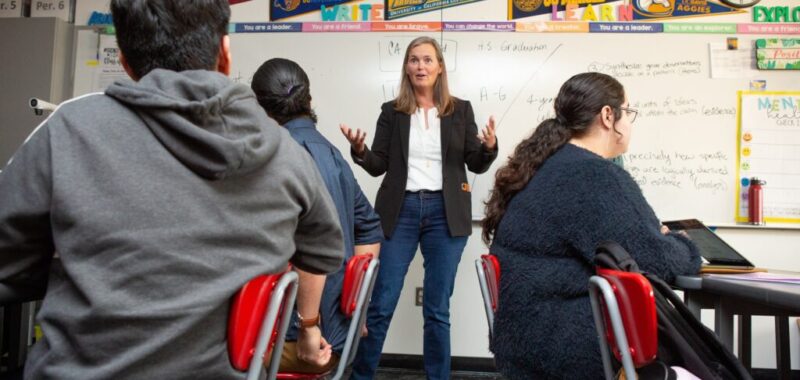
A teacher kicks off a lesson during an AP research class.
Credit: Allison Shelley for EDUimages
High school seniors walked the stage last month, but the FAFSA fiasco has left some still in limbo about their college plans for the fall.
Changes to the Free Application for Federal Student Aid (FAFSA) were supposed to make accessing financial aid easier for students and their families. Instead, it created new challenges for our students at the UCLA Community School, a public LAUSD school located in Koreatown. Despite our best efforts, our predominantly working class, Latino students lived in constant uncertainty around their college plans because issues with the application process led to delays in financial aid packages from universities.
Although it was a frustrating experience, our counseling team found a silver lining — using this opportunity to teach our students how to overcome one of the many systemic challenges they will face as first-generation college students. As a Latino first-gen student myself, I leveraged my lived experiences and worked with colleagues in our College Center to teach our students the critical college knowledge they will need to navigate a system that seems stacked against them.
Working in a community school means intentionally anticipating challenges and systemic barriers students and their families face along their educational journey. Community schools, located in neighborhoods with large numbers of high-needs students, work extra closely with community agencies and local government to provide a range of resources and services to students and families.
Two years ago, we created a College and Careers Transition course to help seniors develop a plan for college and/or careers after high school. However, we didn’t realize how important this course would be until we faced the FAFSA fiasco, which was a huge technical nightmare that delayed aid packages to students who were relying on federal aid to make their college decisions. First-generation college students and underserved communities have always needed support in the application process, but this year, more than ever. Through a collaborative partnership with UCLA, the Fulfillment Fund and Gear Up 4 LA, we helped all students access aid through one-on-one support and educated students and families on how to complete FAFSA once in college.
Although students were given dedicated class time to complete the application, several students needed extra support. One ambitious student, whom I’ll call Nadia to protect her privacy, was accepted to highly selective colleges and would visit the College Center every day seeking support and understanding. The first issue we faced was verifying their parents’ identities. Although the family had created their Federal Student Aid IDs and submitted verification documents as soon as the application opened (late) in January, Nadia was not able to complete the form. This issue occurred for more than half of our students simply because they are part of mixed-immigration status families. Not being able to provide a parent’s signature on the form meant that the Student Aid Index (SAI) could not be calculated, therefore leaving students uncertain of the amount of financial aid they would receive.
Although FAFSA provided temporary workarounds, Nadia was still not able to receive an accurate provisional aid letter by the May 15 deadline observed by most colleges in California. Pressured by looming deadlines she deferred admission to her second-choice college because she did not want to risk committing to a school she could not afford. After checking FAFSA every day for months, the day finally came when Nadia could access her Student Aid Index and she elected to attend community college for academic and financial reasons. In a turn of events, she got off the waitlist for her dream university, the University of Southern California (USC). We spent the week leading up to graduation watching Nadia take the lessons learned from the course as she advocated for herself to secure her aid package from USC. She will start there this year. However, while Nadia had a week to have important financial conversations with family, other students had less than 24 hours or no time at all. Some students felt forced to commit to a school without aid packages or deferred to community college to minimize the financial risk.
While we are hopeful that next year’s FAFSA process will be smoother, this year’s fiasco has helped us build confidence in students and their families who are sending children to college for the very first time. Our transition course affirmed students’ own agency and the power of community. We taught students to have hope and to find it in their circles of support. We also provided coordinated, one-on-one support for every student, which wouldn’t have been possible without the support of UCLA and college access partners like the Fulfillment Fund.
This experience has demonstrated how critical college access programs are in supporting first-generation college students and the many barriers they will face in their higher education journeys.
•••
Jonathan Oyaga is a research associate for UCLA Center for Community Schooling, a campuswide initiative to advance university-assisted community schools, and an educational aide at the UCLA Community School, working in the College and Career Center to support students’ postsecondary transitions.
The opinions in this commentary are those of the author. If you would like to submit a commentary, please review our guidelines and contact us.

